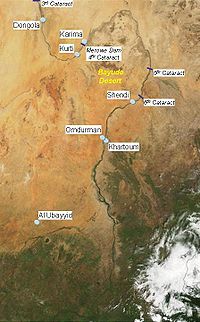Shaigiya tribe
| Shaigiya الشايقيّة |
|
|---|---|

Northern Sudan
|
|
| Ethnicity | Arab |
| Location |
|
| Language | Sudanese Arabic |
| Religion | Sunni Islam |
The Shaigiya (Arabic: الشايقيّة) are one of the largest tribes in northern Sudan.
The Shaigiya are a riverine agricultural people. They claim to descend from Shayig Ibn Humaidan of Beni Abbas, who came from Arabia at the time of the conquest of Egypt in the 7th century and intermixed with Nubian people. Yet according to Nicholls, at the end of the 19th century, none of the Shaigiya nobles would accept Arab descent. The Shaiqi Arabic dialect is well known for its "biting off" of the last letter in a word. Traditionally they have been strongly represented in the army, police and border guards, while other tribes were involved in occupations such as spinning, weaving and transportation.
The tribe's traditional homeland lies on both banks of the Nile from Kurti down to the Third Cataract, and in portions of the Bayuda Desert. The country is the most fertile along the Nile between Egypt and Khartoum. Many of the villages are well built; some of the houses are fortified. The Merowe Dam, just upstream from this area, is disrupting the local population.
They are known for their bravery, generosity, and enlightenment. "They are the one to hunt the Lion." Freedom-loving and hospitable, they had schools in which all Muslim science was taught, and were rich in corn and cattle. Their fighting men, mounted on horses of the famous Dongola breed, were feared throughout the eastern Sudan. Their chiefs wore coats of mail and carried shields of hippopotamus or crocodile skin. Their arms were lance, sword or javelin. The Shaigiya are divided into twelve sections or sub tribes, each descended from one of the twelve sons of the founder, Shaig. Many jokes involve a shaigiya quarrelling with a jayila. Many times the shaigiya is the sharp, and jayila is the stubborn.
They have adopted the tribal marking custom of cutting three horizontal lines on the cheeks of their children. This was done with a heated knife but is now a dying custom.
...
Wikipedia
